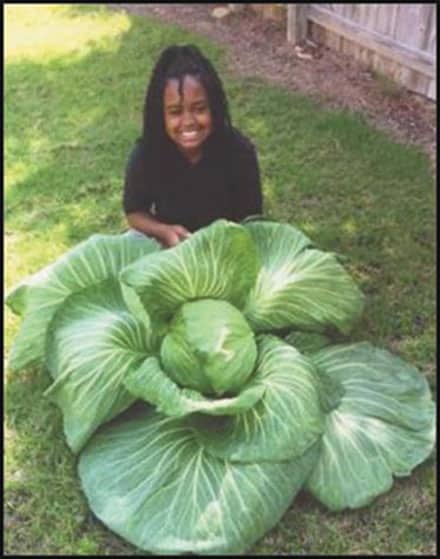
Each year Bonnie Plants, the largest producer of vegetable and herb plants in North America, with 72 stations across the country, trucks free O.S. Cross, or “oversized,” cabbage plants to third grade classrooms whose teachers have signed up for the program online at www.bonnieplants.com. If nurtured and cared for, kids can grow green, giant cabbages, some tipping the scales at 40 pounds!
Launched nationally in 2002, the program awards a $1,000 scholarship to one student in each participating state. At the end of the season, teachers from each class select the student who has grown the “best” cabbage, based on size and appearance. A digital image of the cabbage and student is submitted online at www.bonnieplants.com. That student’s name is then entered in a statewide drawing. State winners are randomly selected by the Commission of Agriculture, in each of 48 particpating states.
“The Bonnie Plants Cabbage Program is a wonderful way to engage children’s interest in agriculture, while teaching them not only the basics of gardening, but the importance of our food systems and growing our own”, said Stan Cope, President of Bonnie Plants. This unique, innovative program exposes children to agriculture and demonstrates, through hands-on experience, where food comes from. The program also affords our youth with some valuable life lessons in nurture, nature, responsibility, self-confidence and accomplishment”.
“Over the course of the past 11 years, the Bonnie Plants Cabbage Program has proved to be an exciting, worth-while experience that children, teacher, parents and grandparents across the country have embraced. We’re pleased and proud to provide our youth with this enjoyable and enriching opportunity and engage their interest in the art and joy of gardening”, said Cope.
Getting It Growing: Growing a colossal cabbage may seem like a giant undertaking for little kids, but it’s easier than you think. All you need to do is:
• Let the Sunshine In: Cabbages need at least six hours of full sunlight, more if possible.
• Survey Your Space: Bonnie O.S. cabbages need at least three feet on each side to spread out. If you don’t have that much space, use a large container.
• Supplement Soil: Work some compost into the soil – cabbages love nutrient-rich soil.
• Feed the Need: Start your cabbage off right with an all-purpose vegetable fertilizer, then fertilize it every 10 days to keep it growing strong.
• Water Wisely: Your cabbage needs at least one inch of rainfall each week. If it doesn’t rain, use a watering can or garden hose to gently water your plant at soil level.
• Tend To Trouble: Keep weeds out of the cabbage patch – they compete for the food and water your cabbage needs. Be on the lookout for brown or white moths – these come from worms that love to munch on cabbage. If you see any, get rid of them right away. Cold weather can damage your cabbage. If the weather gets below 32° F, cover your cabbage with a bucket or clothe covering.
• Hefty Harvest: In just 10 to 12 weeks, you should have a huge head of cabbage you can be proud of.
Green thumbs and perseverance can pay off, providing participating children with as great sense of pride and accomplishment, a humongous cabbage, and for the lucky state winner…. the beginning of an educational fund for college. To see the 2013 winners and learn more about the 2014 contest, visit www.bonnieplants.com
Why a cabbage? Cabbages were the first plant sold by Bonnie in 1918. The cabbages used for the 3rd grade program are OS Cross (over-sized), which is known for producing giant, oversized heads, making the process even more exciting for kids.
Rave Reviews: “The Bonnie Plants Cabbage Program is a wonderful way to engage children’s interest in agriculture, while teaching them not only the basics of biology, but the importance of our food and fiber systems. This innovative program exposes children to agriculture and demonstrates through hand-on experience, where their food comes from. We’re grateful to the people at Bonnie Plants for continuing to provide this program, nationwide, and successfully connect our youth to agriculture”. (FORMER) Alabama Commissioner of Agriculture, Ron Sparks.
“The Third Grade Cabbage Program provides valuable lessons to students about agriculture and the way it touches everyone’s life every day. I commend Bonnie Plants for this program,” (Former) Kentucky Agriculture Commissioner, Richie Farmer.
“The Bonnie Plants Cabbage Program is a wonderful way to engage children’s interest in science. The students learn the life cycle of a plant, how to care for it and what it needs to grow: soil, sunlight, water. Kimberly Dalton, Costner Elementary, North Carolina.
“Every year Bonnie Plants sends us cabbage seedlings, the project teaches students many lessons including how to grow their own food. The biggest lesson I think they learn from this program is how fast vegetables can grow. Students were just amazed and impressed on how fast and easy it was to grow their own food. I think kids sometimes forget that they can grow food so this is a great lesson!” Jennifer Bloom, Russell Ranch Elementary, Folsom, CA
It’s good for the students to get out there and grow their own plants. It helps them learn about nature, soil composition and the parts of plants, but it also shows them where things come from,” she said. “So many young people take for granted the fact that we can walk into the store and buy whatever we want. It’s a good history lesson for them to learn that it wasn’t always like that, even in this country”.
Melody Witt, Alto Elementary Principal, Texas

